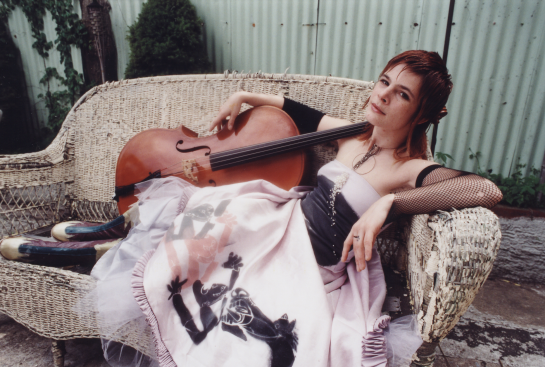By Ali Siemens (The Cascade) – Email
Print Edition: April 4, 2012
I was fortunate enough to be put in contact with the talented cellist Bonfire Madigan who will be visiting The Reach Museum in Abbotsford on April 5. Her take on what music is and where she finds inspiration is all explained in the most understandable form; Madigan’s ability to draw the reader through her music is just as prominent in her answers in this interview.
What is music to you?
A universal language for emotions.
When you write music, do you have a routine? What is the atmosphere like?
I feel that I am always writing music, taking notes on bits of conversation, poetry, ambient living sounds and allowing ample moments for the puzzle pieces to coalesce into a song form or piece of art music. Whenever I am practicing I leave this space for the new motifs and ideas to percolate into the shape of new works.
How important is classical training?
I believe that in any craft you engage in, working on your fundamentals is essential … practice, patience, and due diligence go a long way in evolving any activity you enjoy doing.
Who are your role models in music?
A few jumping to mind today include Meredith Monk, Arthur Russell, Bjork, Tom Waits, Yoko Ono, Evelyn Glennie … this list could go on and on depending on which day you ask me.
Who is on your iPod?
Rostropovich, Carla Morrison, TV on the Radio, Wild Flag, Dirty Three, Nina Simone and Warpaint.
What kind of music did you grow up listening to? Did it shape your musical tastes today?
My dad exposed me to the music he loved. Of course this is probably some of the defining rebel rock, best popular music of the last century including his favorites: Jimi Hendrix, Neil Young, Bob Marley, John Lennon … so yes, I was deeply impacted and invigorated as a young musician by being exposed early to the mastery of these artists who still inspire anyone who loves listening and creating music. I feel very lucky that my pop exposed me to such quality artists at such a young age. He has great ears!
What does success look like to you as an artist?
Sustainability. To have sustainable support bases and business assistance with which I am able to write, perform, share my work. I would like to get to continue on towards evolving a time and place where a core group of patrons, friends, fans ensure I will have the space and resources to continue making art and music and bring into and around the world – well into my golden years.
What are some of your favourite memories of musical performance?
Performing on the classical stage at Bumbershoot in Seattle and playing so ferociously on the encore finale that my G string snapped right off the cello to a roaring standing ovation. The engineers up in the sound booth found this so spectacular (and rather hilarious) that when I returned a couple years later they brought me up to the booth to show me the string they had recovered from the stage, framed with the poster from the show with the description, “The night Bonfire Madigan broke her G string here on our humble classical stage.” They then asked me to sign the poster. It was very sweet and silly coming from that scene of music in particular.
What are some of your hopes and dreams regarding music?
I have a dream that music and sound art healing will become integrated into collective medicine and wellness. We are just at the beginning [of] understand[ing] that drugs and surgery can be outmoded forms of preventative and long term health and that in fact intention, narrative, vibrational sound frequency and energy healing have unprecedented results on our collective future.
Does your cello have a name? If so, how did it get its name?
This is a timely question because yes in fact it does: Miranda. My unstoppable Miranda cello. The name was just sealed by an unfortunate but perhaps destined happening a couple months ago when I was on tour in Europe. On our trip from Berlin to Barcelona my cello was damaged very, very badly in transit (in fact, I am still paying off the repairs as I discovered, alarmingly, an awful loophole in my insurance that would not cover the damages).
Well me and this cello have been on tour and in studio together for over a decade now and she is just about to have her centennial birthday next year, although some shops assessed that she [might] not make it back to playable. There is no giving up on her. Her tone, our instincts, those hundreds of harmonics, she is my favourite partner thus far in my composer/performer/singing-cellist career journey. Fortunately, I was able to find an amazingly progressive luthier [sic] who brought her back to life using carbon fiber rods, the same material used on space shuttles.
Thus the name comes from the moon Miranda circling Uranus. It is understood that this unique unflappable satellite has been smashed so many times that you can actually nearly see through parts of it (kind of like Willie Nelson’s trusty ‘ole Martin guitar) but because of the fierce pull of it’s partner planet it continues to orbit proudly: just like my Miranda cello.


